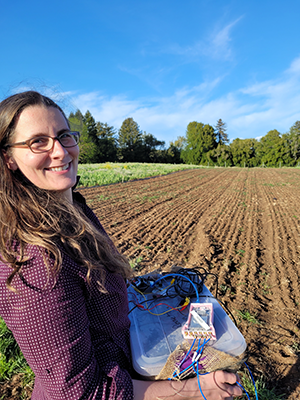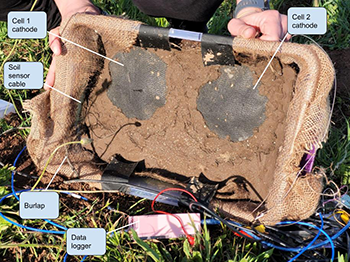Engineer Deploys Research On 'Mud Batteries' For Powering Sustainable Agriculture
The UCSC farm hosts one of the first field research sites for studying the potential of microbial fuel cells
 Assistant Professor of Electrical and Computer Engineering Colleen Josephson has deployed research on "mud batteries" at the UCSC farm.
Assistant Professor of Electrical and Computer Engineering Colleen Josephson has deployed research on "mud batteries" at the UCSC farm.
With growing populations, climate change, and high levels of consumption, many areas of the world can expect to face water shortages by 2050. The majority of freshwater on earth is used for agriculture, driving the need for soil moisture sensing systems that are proven to help farmers more efficiently water their crops. While this tool has the potential to minimize or avoid a water crisis, it is not widely used due to cost and difficult maintenance.
Microbial fuel cells, a method for gathering tiny amounts of energy from bacteria that live in soil, are a potential solution to provide renewable energy to power soil moisture detection systems on farms. UC Santa Cruz Assistant Professor of Electrical and Computer Engineering Colleen Josephson published new research exploring the current state of this technology and future opportunities for expanding its efficacy and impact.
The farm at UCSC currently hosts one of the only sites in the world to test this technology in the field, as Josephson’s group and her collaborators experiment with the efficacy of microbial fuel cells, also called mud batteries, outside of a laboratory.
“To our knowledge, we’re the first to be looking at how we can use these microbial fuel cells in outdoor sensor networks,” Jospehson said. “Some of our early results have been pretty exciting, showing that we can incubate these cells in a laboratory environment and then move them out to a farm field and generate power in a relatively steady state.”
Past research has shown that monitoring the levels of water in a crop field can help farmers better water their crops, maintaining yields while using 20 to 50 percent less water. But today, fewer than 10 percent of farms in the U.S. use intelligent watering systems. Josephson and her coauthors on the new research (Weitao Shuai and George Wells at Northwestern University, Pat Pannuto and Gabriel Marcano and UC San Diego, and Josiah Hester at the Georgia Institute of Technology) believe this technology can be leveraged for the resilience of food-producing ecosystems, allowing us to farm and feed ourselves as sustainability as possible while minimizing impact on the planet.
An emerging technology
While employed at Microsoft Research before joining Baskin Engineering, Josephson worked on a project to develop lower-cost sensing solutions for agriculture, an area that combined her expertise in low-power wireless communication systems and her personal interests in biology, gardening, and food systems.
After a few years of research, her team came up with technology that could monitor soil moisture at a fraction of the cost of other systems and was significantly easier for farmers to deploy and maintain. The system was designed to last five-years on a single coin-cell battery, but the researchers wanted to push for a renewable system where the users would never have to worry about their power source.
“We had been looking at how we can overcome the challenges of supplying power to the farm field, and we found out about some work that had been going on about harvesting energy from naturally occurring microbes in the soil,” Josephson said. “That seemed like a really exciting thing to pair with this low-cost soil moisture sensing work.”
Microbial fuel cells work by harvesting energy from specific soil bacteria called exoelectrogens. As these bacteria eat nutrients, they essentially “breathe out” solid state electron acceptors, which can be routed to a circuit and used to produce power. The microbial fuel cell itself operates at a very low voltage, so the scientists use a power harvesting chip to condition the electricity to be at a voltage compatible with the electronics system
 A microbial fuel cell with components labeled.
A microbial fuel cell with components labeled.
But the researchers have found that today’s power harvesting chips that are optimized for other energy sources such as solar or kinetic don’t do a good job of harvesting energy from mud batteries. The algorithms baked into these state-of-the-art chips end up negatively affecting the bacteria, making them produce power at far below their peak. To their surprise, the researchers found a simple, static resistor does a better job of harvesting energy than existing smart algorithms for other applications.
Josephson is planning future research around how to redesign the power harvesting chips to more effectively use microbial power sources.
Microbial fuel cells are not a new invention and have been an area of interest for researchers such as civil engineers looking to harvest energy from wastewater. But harvesting energy from the soil is a less common area of research, and one that traditionally has not been an area of focus for electrical engineers, likely because until recently, electronics were not low-power enough to effectively leverage the tiny amounts of power these fuel cells produce.
“This is not a replacement for your wall jack – this is a special power source designed for really rugged environments, where we can put long-lived sensor systems in places we've never been able to have them before.”
Future opportunities
The health of microbes is extremely important for the overall health of the soil, just like the health of the microbes in our guts is key to a healthy digestive system. In addition to powering soil moisture sensing, monitoring the power output of the soil microbes could give clues to the well-being of the environment.
“It's not perfect, but at the very least it could be a very interesting way to do early detection,” Josephson said. “If these electrogenic bacteria are dying, maybe all the other bacteria are unhappy, too, and then you could go and do some additional testing.”
It is currently difficult to do real-time, in-ground monitoring of some of the factors that play into microbe health, such as the nitrogen levels in the soil. But because power that’s produced fluctuates based on temperature, soil moisture, and the nutrients in the soil, Josephson thinks that analyzing traditional metrics like soil moisture, temperature and electrical conductivity along with the novel metric of power output of the microbial system could be a way to keep an eye on overall microbial health – a concept called “sensor fusion.”
“If you know how the microbes normally behave given temperature, time of year, and irrigation level, and you see that the power output is anomalous given the current system conditions, then you can infer that some property we can’t yet effectively monitor might be the culprit.”
While the mud batteries are currently being tested on the farm at UCSC as well as at Stanford University, Josephson is looking to deploy them on farms around the country to see how the fuel cells behave in other climates, under pressures such as different soil makeup or the freezing temperatures of the Midwest and New England. In addition to furthering the batteries themselves, this would benefit the development of sensor fusion in that having more data from a diversity of climates could help the researchers better understand what conditions keep the bacteria healthy.
Beyond agriculture, Josephson says that she and her collaborators are interested in further innovating these systems to monitor wetlands, marshlands, and ocean water environments.
“We think it's time that more people are hearing about these fuel cells and how interesting and impactful they could be,” Josephson said.
Publication: Colleen Josephson, et al., The Future of Clean Computing May Be Dirty, Association for Computing Machinery (2022). DOI: 10.1145/3568113.3568117
Original Story Source: UC Santa Cruz

 Alerts Sign-up
Alerts Sign-up